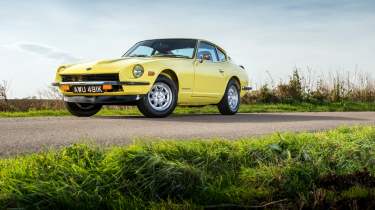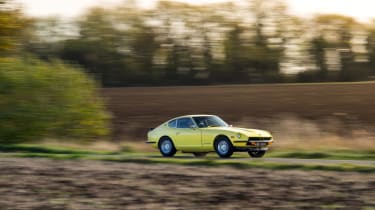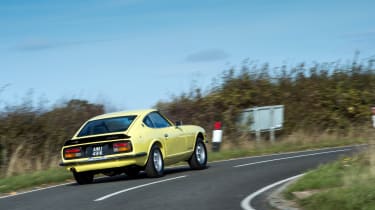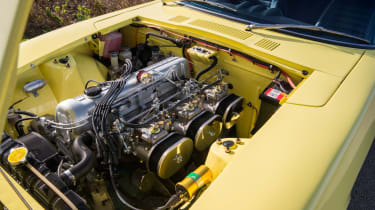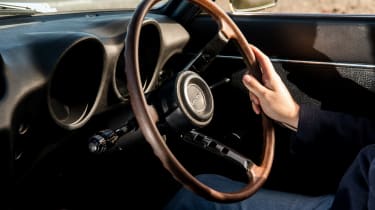Datsun 240Z – review, history, prices and specs
Sports cars have come a long way, but the Datsun 240Z is just as good 50 years on
2019 marks 50 years since one of Nissan’s, and indeed Japan’s most important ever cars first went on sale. It’s the 50th anniversary of the ‘Z-car’ (cooler if pronounced with the American ‘zee’), a lineage that began with the 240Z way back in 1969.
The Z was only ever a small player in the UK, but it virtually built the Datsun, and subsequently Nissan brands in the United States. It created a legacy that has continued to this day, most recently through the characterful, if long-in-the-tooth 370Z.
> Click here for our review of the Nissan 370Z Nismo
A resurgence in popularity has seen Z-car prices rise in recent years, but their roaring desirability, at least in the US, means choice is still relatively plentiful, if you’re prepared to import a left-hand-drive car. For the styling, character and driving entertainment they deliver, there are few attainable classics that match it.
Datsun 240Z in detail
The Datsun 240Z story starts with Yutaka Katayama, tasked with bringing the Datsun brand to the United States in the early 1960s. Early products, mostly small utility vehicles, sold slowly, but Katayama saw a gap in the market for small sports cars like those produced by the British, and 1963’s 1500 Fairlady roadster achieved reasonable success.
More reviews
Group tests
- Alpine A290 v Alpine A110 – how much DNA do they really share?
- Ariel Atom 4R v Caterham Seven ‘evo25’: power-to-weight heroes go head-to-head
- Aston Martin Vantage vs Audi R8 V10 RWD – back to basics
- Caterham Super Seven 600 v Super Seven 2000
- Levante v T1
- Corvette Stingray v Porsche Cayman GTS v Audi R8 RWD
- Great Ferrari hypercars driven: 288 GTO, F40, F50 and Enzo head-to-head
- Lamborghini Aventador Ultimae v Lamborghini Countach
- Lotus Emira v Morgan Plus Four – four-cylinder Brits go head-to-head
- Toyota GR86 v BBR Mazda MX-5: supercharged drop-top battles sports coupe
In-depth reviews
- Abarth 600e 2025 review – Italy gives the Alpine A290 something to worry about
- Alpine A110 review – distinctive, lightweight and unforgettable to drive
- Audi RS7 Sportback Performance review
- Bentley Continental R Mulliner: review, history and specs
- BMW 5-series review – is this still Munich’s anchor model?
- BMW 1-series review – Munich’s Audi A3 rival gains focus
Long term tests
- Abarth 695C Turismo Fast Fleet test – 10,000 miles in the Italian hot hatch
- Alfa Romeo Giulia Veloce Fast Fleet test – 7000 miles in the sharp Italian saloon
- Alpina B10: end of term report
- Alpina B10
- Ford Mustang GT
- Ford Mustang GT
- Ford Mustang GT
- Land Rover Defender 110 Fast Fleet test – 9000 miles in the go-anywhere SUV
- Maserati Ghibli Trofeo Fast Fleet test – 4000 miles in the Ferrari-powered saloon
- Mitsubishi Evo MR 340
Review
- New Aston Martin DBS 770 Ultimate review – 759bhp super-GT driven
- New Bentley Batur 2023 review – can it possibly be worth £1.65m?
- 2023 Chevrolet Corvette C8 Z06 review – the American 911 GT3?
- Kia EV6 GT-Line S prototype review – the EV that shows how it’s done
- BBR Supercharged Mazda MX-5 (ND) 2023 review – tuned 250bhp roadster driven
- MG4 Trophy 2023 review
Reviews
- Abarth 695 75 Anniversario edition 2024 review – a fitting send-off for Abarth’s hot supermini?
- Abarth 500e 2023 review
- AC Cobra 378 Superblower MkIV 2021 review – another V8 Cobra, but with a GM heart this time
- Acura Integra Type S 2024 review – a Honda Civic Type R with added restraint
- Alfa Romeo Giulia 2025 review – get one while you still can
- Alfa Romeo SZ: history, review and specs of an icon
- Alfa Romeo 1750 TBi
- Alpina B3 GT Touring 2025 review – a 190mph alternative to the BMW M3 Touring
This gave Katayama the clout among Nissan’s top brass to encourage the development of further sports cars, and the Datsun 1600 and Sports 2000 roadsters that followed proved increasingly popular – particularly with high-profile motorsport success at the hands of drivers like Peter Brock and Bob Sharp proving the old ‘win on Sunday, sell on Monday’ adage.
Katayama’s persistence with sports cars paid off, Nissan eventually creating the S30 Fairlady Z, known in America and elsewhere as the 240Z on account of its 2.4-litre, in-line six-cylinder engine. A starting price of $3526 in 1969 – equivalent to around £18,500 in 2019 money at the current exchange rate – guaranteed its success.
Of course, the ingredients were right too. The two-seat steel monocoque used MacPherson struts and an anti-roll bar up front, and Chapman struts at the rear. Brakes were discs up front and drums at the back, and the 150bhp ‘L24’ six-pot was well matched to a relatively spry kerb weight of 1068kg – not far different from that of a modern Mazda MX-5 RF.
That gave it punchy performance for 1969; if not quite the match of some bona-fide Pony cars, then eight seconds to 60mph and a top speed of 125mph was nothing to be sniffed at. Early gearboxes had four speeds, but a five-speed manual was used outside of the US.
Cleverly, Nissan didn’t rest on its laurels with the 240Z. While the car was still dominating on the racetrack – Sharp, as well as John Morton and Paul Newman all drove examples – Nissan worked on upgrading the 2.4-litre engine, with the 2.6-litre 260Z arriving in 1974. The power increase was modest and the performance increase minimal, but they did offset extra emissions controls introduced to combat pollution and fuel efficiency worries. Styling tweaks were minor too, though a slightly less elegant 2+2 model brought extra practicality.
The Zed was upgraded again from 1975 for the US market only, becoming the 280Z, with a corresponding increase in capacity and small improvements in power and torque. As was common at the time, safety regulations and styling trends saw larger plastic bumpers sprout from either end, harming the Z’s lines.
It, and the 260Z in other markets, carried on the Z line until the S130-chassis 280ZX arrived in 1978. By this point the Z had become more of a grand tourer than a sports car, a trend continued by two generations of 300ZX in 1984 and 1990, but the 350Z of 2003 brought things back to basics for the nameplate, putting performance and design at the forefront.
Rarest of the S30 models was Japan’s Fairlady Z432. Only around 420 were built, all for the Japanese market, and swapped the brawny but relatively simple ‘L24’ in-line six for a revvy 2-litre ‘S20’ in-line six from the contemporary Nissan Skyline GT-R. The ‘432’ in its name derives from the engine’s specifications – four valves per cylinder, three carburettors, twin camshafts.
Driving a 240Z today is still a joy. While it obviously lacks the performance of many modern sports cars, the light weight and compact size go a long way to making up for it, as does the smooth punch of what’s still a reasonably large engine for such a car.
Find a good one and there’s still plenty of power in the original discs and drums too, while the clutch and gearbox are light and easy, removing one of the common woes of driving an older vehicle. There’s a satisfyingly long travel to the throttle pedal, and on the example we drove at least, it was best with the butterflies fully open – at which point it stopped stumbling and coughing and produced a fantastic straight-six note.
It’s a neat handler too, with good grip, surprisingly precise (and far from heavy) steering, and enough composure even on relatively poor surfaces to give you confidence to drive hard. As we discovered in issue 259, there are also specialists out there, like the Bradford-based MZR Roadsports, who will make it even better, too.
Datsun 240Z specs
What we said
evo 259, ‘Day of the Zed’ (Apr 19)
‘A rousing, full-bodied induction roar and surprising turn of pace are further incentive to push the long-travel throttle to the floor, and the long throw of the five-speed ’box (early cars had four ratios) feels well matched to the deep-chested power plant.
‘There’s real balance to the chassis, too. You’d need fists of ham to get it out of shape at road speeds, but you can feel the tyres loading up and feedback squirming through the thin, woodette wheel rim as if you’re driving a bigger and slightly lazier early MX-5. I’m sold by the time I’m a mile up the road.’

